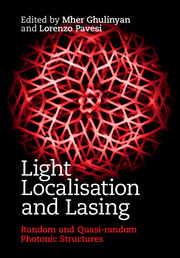Book contents
- Frontmatter
- Contents
- List of contributors
- Preface
- 1 Light propagation and emission in complex photonic media
- 2 Transport of localized waves via modes and channels
- 3 Modes structure and interaction in random lasers
- 4 Ordered and disordered light transport in coupled microring resonators
- 5 One-dimensional photonic quasicrystals
- 6 2D pseudo-random and deterministic aperiodic lasers
- 7 Three-dimensional photonic quasicrystals and deterministic aperiodic structures
- 8 Cavity quantum electrodynamics with three-dimensional photonic band gap crystals
- References
- Index
7 - Three-dimensional photonic quasicrystals and deterministic aperiodic structures
Published online by Cambridge University Press: 18 December 2014
- Frontmatter
- Contents
- List of contributors
- Preface
- 1 Light propagation and emission in complex photonic media
- 2 Transport of localized waves via modes and channels
- 3 Modes structure and interaction in random lasers
- 4 Ordered and disordered light transport in coupled microring resonators
- 5 One-dimensional photonic quasicrystals
- 6 2D pseudo-random and deterministic aperiodic lasers
- 7 Three-dimensional photonic quasicrystals and deterministic aperiodic structures
- 8 Cavity quantum electrodynamics with three-dimensional photonic band gap crystals
- References
- Index
Summary
This chapter presents an overview of the state-of-the-art of photonic three-dimensional deterministic aperiodic structures with a special emphasis on photonic quasicrystals. Reaching out into the third dimension has its own challenges. As discussed in detail in the preceding chapters, generating a deterministic aperiodic structure in one and two dimensions requires correctly calculated layer thicknesses (one dimension) or positions on a plane, where material is removed (forming holes) or added (forming cylinders, dots or other objects). Because of solid substrates all of these structures are inherently stable and one can concentrate directly on their physical properties. Having a properly calculated point-set does not necessarily help in three dimensions. Without supporting structures holding the building blocks in position, all of these constructs will collapse. Hence, devising proper support structures which do not alter the overall properties under study is one challenge; the second being the actual fabrication. For photonic structures feature sizes have to be on a scale of 100 nm and separation between features should not exceed a few microns – hence, part of this chapter is dedicated to technological questions. Because of these challenges there are only a limited number of groups working on three-dimensional aperiodic structures, a field which is just starting to expand. However, the benefit of reaching into the third dimension is to create a real material showing perhaps surprising properties, like the three-dimensional quasicrystals Shechtman et al. [428] discovered in 1984.
In Section 7.1 we will briefly classify the different aperiodic sequences used later on with respect to their Fourier spectra, especially keeping in mind that three-dimensional structures can only be of finite dimensions. Section 7.2 is then dedicated to the generation of three-dimensional point-sets and proper support structures, presenting the cut-and-project method as a powerful tool for generating quasicrystalline structures with almost any desired symmetry properties. Fabrication technologies with respect to three-dimensional aperiodic structures are briefly summarized in Section 7.3, before Section 7.4 presents three-dimensional realizations of quasicrystals and deterministic aperiodic structures.
- Type
- Chapter
- Information
- Light Localisation and LasingRandom and Pseudo-random Photonic Structures, pp. 146 - 179Publisher: Cambridge University PressPrint publication year: 2014
- 1
- Cited by



